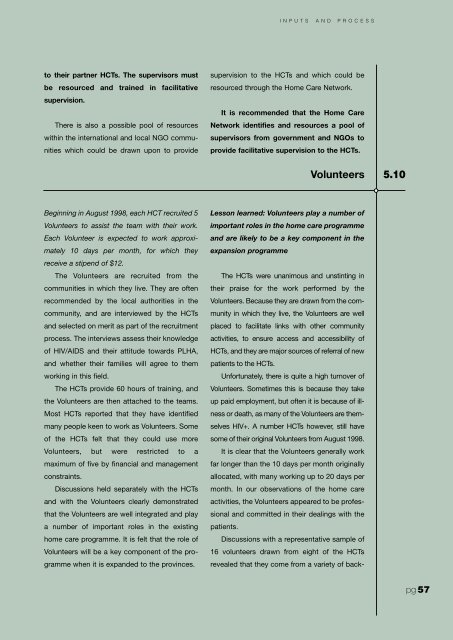PDF File - hivpolicy.org
PDF File - hivpolicy.org
PDF File - hivpolicy.org
- No tags were found...
You also want an ePaper? Increase the reach of your titles
YUMPU automatically turns print PDFs into web optimized ePapers that Google loves.
INPUTSAND PROCESSto their partner HCTs. The supervisors mustbe resourced and trained in facilitativesupervision.There is also a possible pool of resourceswithin the international and local NGO communitieswhich could be drawn upon to providesupervision to the HCTs and which could beresourced through the Home Care Network.It is recommended that the Home CareNetwork identifies and resources a pool ofsupervisors from government and NGOs toprovide facilitative supervision to the HCTs.Volunteers 5.10Beginning in August 1998, each HCT recruited 5Volunteers to assist the team with their work.Each Volunteer is expected to work approximately10 days per month, for which theyreceive a stipend of $12.The Volunteers are recruited from thecommunities in which they live. They are oftenrecommended by the local authorities in thecommunity, and are interviewed by the HCTsand selected on merit as part of the recruitmentprocess. The interviews assess their knowledgeof HIV/AIDS and their attitude towards PLHA,and whether their families will agree to themworking in this field.The HCTs provide 60 hours of training, andthe Volunteers are then attached to the teams.Most HCTs reported that they have identifiedmany people keen to work as Volunteers. Someof the HCTs felt that they could use moreVolunteers, but were restricted to amaximum of five by financial and managementconstraints.Discussions held separately with the HCTsand with the Volunteers clearly demonstratedthat the Volunteers are well integrated and playa number of important roles in the existinghome care programme. It is felt that the role ofVolunteers will be a key component of the programmewhen it is expanded to the provinces.Lesson learned: Volunteers play a number ofimportant roles in the home care programmeand are likely to be a key component in theexpansion programmeThe HCTs were unanimous and unstinting intheir praise for the work performed by theVolunteers. Because they are drawn from the communityin which they live, the Volunteers are wellplaced to facilitate links with other communityactivities, to ensure access and accessibility ofHCTs, and they are major sources of referral of newpatients to the HCTs.Unfortunately, there is quite a high turnover ofVolunteers. Sometimes this is because they takeup paid employment, but often it is because of illnessor death, as many of the Volunteers are themselvesHIV+. A number HCTs however, still havesome of their original Volunteers from August 1998.It is clear that the Volunteers generally workfar longer than the 10 days per month originallyallocated, with many working up to 20 days permonth. In our observations of the home careactivities, the Volunteers appeared to be professionaland committed in their dealings with thepatients.Discussions with a representative sample of16 volunteers drawn from eight of the HCTsrevealed that they come from a variety of back-pg 57
















